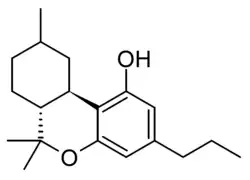Hexahydrocannabivarin
 | |
| Identifiers | |
|---|---|
| |
| CAS Number | |
| Chemical and physical data | |
| Formula | C19H28O2 |
| Molar mass | 288.431 g·mol−1 |
| 3D model (JSmol) | |
| |
| |
Hexahydrocannabivarin (HHCV, HHC-V) is a semi-synthetic cannabinoid derivative, the hydrogenated derivative of tetrahydrocannabivarin (THCV). It was first synthesised by Roger Adams in 1942 and produces only weak cannabinoid-like effects in animals.[1] More recently it has been sold as an ingredient in grey-market cannabinoid products. It has been investigated for potential antineoplastic activity in vitro.[2][3]
See also
References
- ^ Adams R, Loewe S, Smith CM, McPhee WD (March 1942). "Tetrahydrocannabinol homologs and analogs with marihuana activity. XIII". Journal of the American Chemical Society. 64 (3): 694–697. doi:10.1021/ja01255a061.
- ^ Cruces W, Tesfatsion TT, Ramirez GA, Docampo-Palacios ML, Collins AC, Ray KP, et al. (June 2025). "Synthesis, Characterization, and in vitro Experiments of Saturated Cannabinoids on Pancreatic Ductal Adenocarcinoma Cell Lines (HPAF-II, MIA-PaCa2, ASPC-1, and PANC-1)". Natural Product Communications. 20 (6): 1–11. doi:10.1177/1934578X251348390.
- ^ Docampo-Palacios ML, Ramirez GA, Tesfatsion TT, Okhovat A, Pittiglio M, Ray KP, et al. (September 2023). "Saturated Cannabinoids: Update on Synthesis Strategies and Biological Studies of These Emerging Cannabinoid Analogs". Molecules. 28 (17). Basel, Switzerland: 6434. doi:10.3390/molecules28176434. PMC 10490552. PMID 37687263.